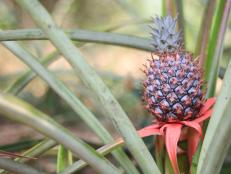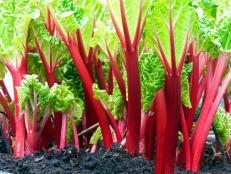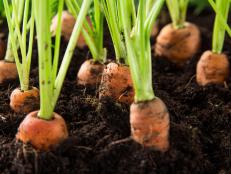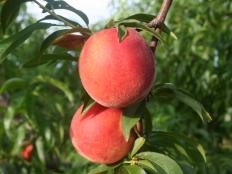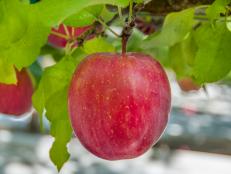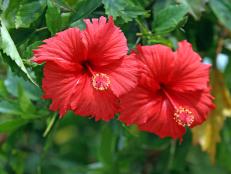How to Grow Dragon Fruit From Seed
These bold, dramatic plants thrive indoors and out.

GettyImages/Rakratchada Torsap

Whether magenta and green or bright yellow, the vivid colors of a dragon fruit are hard to miss in a grocery store produce aisle. The fruit tastes mild and subtle, with many small, dark seeds adding a satisfying crunch. This exotic fruit hails from an equally exotic plant — a tropical form of cactus native to Central America.
If dragon fruit has intrigued you, the small seeds scattered throughout its flesh can be sprouted easily and grown into a dragon fruit plant of your own. Plants can begin flowering in as little as six to eight months, although container-grown plants may take up to two years to bear fruit. The good news is that once the plant is mature, you could see four to six fruiting cycles a year from a plant that is capable of bearing fruit for 20 to 30 years.
Starting the Seeds
To grow dragon fruit from seed, slice a dragon fruit in half and use a spoon to scrape out some seeds. Rinse the seeds. Pulp will cling to the seeds, and it’s fine to plant with it attached. Fill a cup or small pot with sterile seed starter or cactus soil mix. Moisten the soil but avoid saturating it with water. Use the spoon to mix the seed into the top quarter inch of soil. Mist if needed to ensure this layer is moist and then cover with a plastic sandwich bag or clear food wrap. The cover will retain moisture and warmth.
Top 10 Rules for Growing a Kitchen Garden 10 Photos
Growing fruits and vegetables isn't rocket science, but it does involve science. Here are easy tips to help ensure your success in growing food in the garden.
Place the pot under a grow light or in a sunny window. Keep warm and lightly water when needed. The seeds will sprout within 30 days and perhaps much sooner. Thin the seedlings or separate them and give some to friends.
Growing Outdoors
Dragon fruit can grow in the ground in USDA zones 9 through 11, although they must be protected from frost in zone 9. Outdoor dragon fruit thrive in sunny spots or in filtered sun in intensely hot areas. Temperatures that exceed 100 will harm the plant and cause wilt. In areas that receive lots of rain, site the plant on a hill or small mound so water will drain away. Add composted manure or other organic material to planting holes along with some slow-release fertilizer to speed growth.
Growing in Containers
In cooler climates, dragon fruit are ideal for containers. They grow well in a greenhouse, sunroom or indoors placed about two feet away from a sunny south-facing window. Plant lights, such as LEDs on timers, can be used to supplement natural light if needed.
To grow as a container plant, transplant a seedling into a pot with good drainage and use a cactus soil mix or one you blend yourself of sand and potting soil. Add compost to either mix. When the young dragon fruit is six inches tall, move it into a pot that is 15 to 24 inches wide and at least 10 inches deep. Add a trellis or climbing pole to the pot and tie the plant to the support. Outdoor dragon fruits require similar supports, or an arbor, since this is a climbing plant.
Fruits and Vegetables That Grow in the Shade 17 Photos
Though most vegetable plants require full sun (6+ hours a day) to produce the fresh foods we love, some vegetables and fruits can grow in partial shade.
Fertilizing
Begin feeding at three months of age using a low-nitrogen cactus fertilizer or granular 8-4-12 palm fertilizer. Dragon fruit are light feeders, so apply fertilizer every two months only while the plant is actively growing. In cooler areas, the plant will become dormant in fall. Stop fertilizing then and water less frequently until growth resumes in the spring.
Pruning
Fall is the time to prune larger dragon fruit. Sterilize your pruning shears, then remove any decaying or dead foliage or stems. Also, trim to open up areas that are crowded to improve airflow. Left on their own, dragon fruit can grow 20 feet high, so annual pruning is a must. Growth can be vigorous, and mature indoor plants will ultimately need a 20-gallon container.
Pollinating and Harvesting
When the plant begins to flower, prepare for a treat. Buds develop for several weeks, then, when ready to bloom, they open for just one night. Their showy flowers are among the largest in the plant world and release an intoxicating scent. While some dragon fruit plants are self-pollinating, others depend on bats or moths for pollination. To ensure success, it’s best to have a cotton swab on hand and transfer the pollen yourself. Online tutorials show how. Done successfully, the fruit will follow. Leave fruit on the plant until its colors become vivid. When the fruit has a slight give, it is time to harvest and savor the tasty fruit of your labor.








